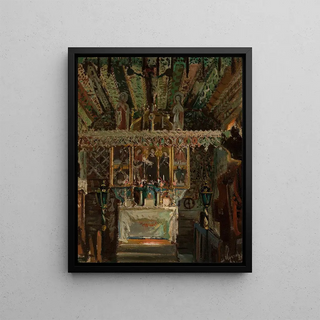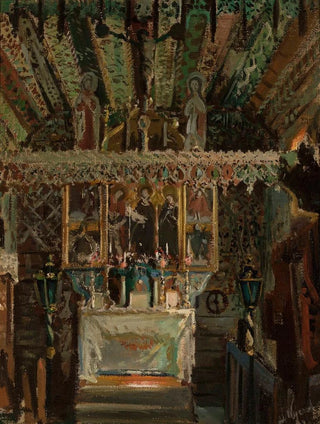Art print | Interior of the church of Dębno - Leon Wyczółkowski


View from behind

Frame (optional)
Interior Art print of Dębno Church - Leon Wyczółkowski – Captivating Introduction
The "Interior of Dębno Church" by Leon Wyczółkowski presents itself as an open window to a world where light and shadow dance harmoniously. This painting, created at the end of the 19th century, transports us into a sacred space, where every detail seems to whisper the stories of the faithful who have tread this ground. Wyczółkowski, master of landscape and architecture, manages to capture the very essence of this interior, revealing an atmosphere imbued with serenity and spirituality. By contemplating this work, the viewer is invited to immerse themselves in a sensory experience, where the beauty of architecture meets the depth of faith.
Style and uniqueness of the work
Wyczółkowski's style is characterized by a realistic approach, blended with an impressionist sensitivity. In "Interior of Dębno Church," he uses delicate brushstrokes to evoke the texture of the walls, the richness of the stained glass colors, and the filtered light illuminating the space. Warm tones and subtle nuances create an almost palpable atmosphere, allowing the viewer to feel the tranquility that reigns within this edifice. The composition is carefully orchestrated, with each element finding its place, from liturgical furniture to the silhouettes of the faithful, all contributing to the harmony of the whole. This work stands out for its ability to transcend the simple visual register, inviting meditative contemplation.
The artist and his influence
Leon Wyczółkowski, born in 1852, is one of the emblematic figures of Polish art. His artistic journey is marked by a constant quest for authenticity and beauty in everyday life. Influenced by the great masters of European painting, he develops a personal style that combines tradition and modernity. His fascination with landscapes and architecture leads him to explore various subjects, but it is in the depiction of church interiors that he particularly excels. Wyczółkowski does not merely reproduce scenes; he seeks to capture the soul of the places, to reveal

Matte finish

View from behind

Frame (optional)
Interior Art print of Dębno Church - Leon Wyczółkowski – Captivating Introduction
The "Interior of Dębno Church" by Leon Wyczółkowski presents itself as an open window to a world where light and shadow dance harmoniously. This painting, created at the end of the 19th century, transports us into a sacred space, where every detail seems to whisper the stories of the faithful who have tread this ground. Wyczółkowski, master of landscape and architecture, manages to capture the very essence of this interior, revealing an atmosphere imbued with serenity and spirituality. By contemplating this work, the viewer is invited to immerse themselves in a sensory experience, where the beauty of architecture meets the depth of faith.
Style and uniqueness of the work
Wyczółkowski's style is characterized by a realistic approach, blended with an impressionist sensitivity. In "Interior of Dębno Church," he uses delicate brushstrokes to evoke the texture of the walls, the richness of the stained glass colors, and the filtered light illuminating the space. Warm tones and subtle nuances create an almost palpable atmosphere, allowing the viewer to feel the tranquility that reigns within this edifice. The composition is carefully orchestrated, with each element finding its place, from liturgical furniture to the silhouettes of the faithful, all contributing to the harmony of the whole. This work stands out for its ability to transcend the simple visual register, inviting meditative contemplation.
The artist and his influence
Leon Wyczółkowski, born in 1852, is one of the emblematic figures of Polish art. His artistic journey is marked by a constant quest for authenticity and beauty in everyday life. Influenced by the great masters of European painting, he develops a personal style that combines tradition and modernity. His fascination with landscapes and architecture leads him to explore various subjects, but it is in the depiction of church interiors that he particularly excels. Wyczółkowski does not merely reproduce scenes; he seeks to capture the soul of the places, to reveal






